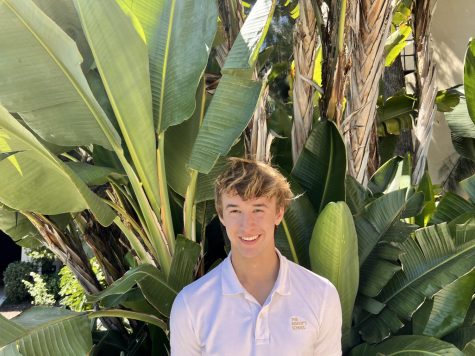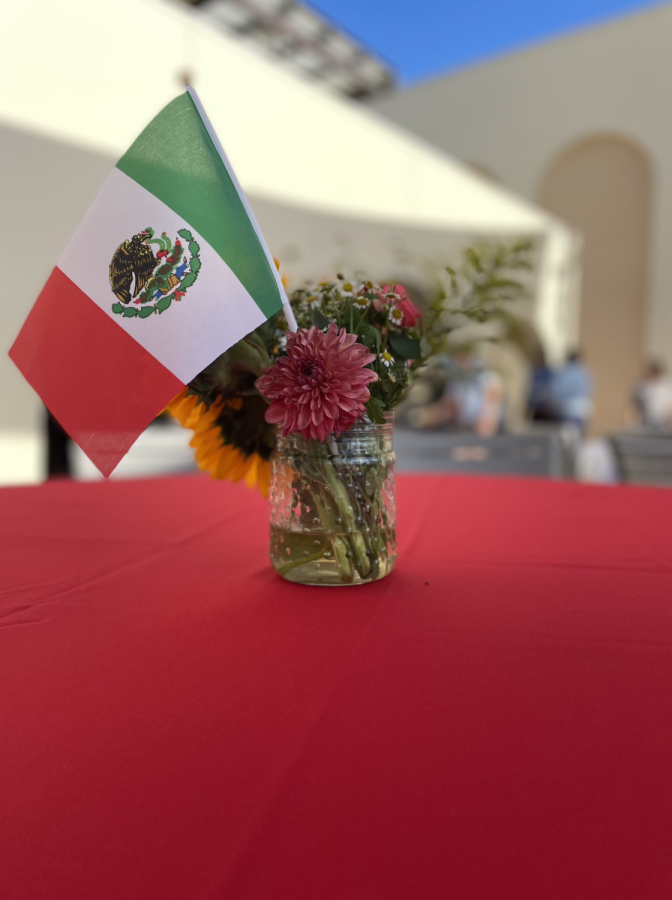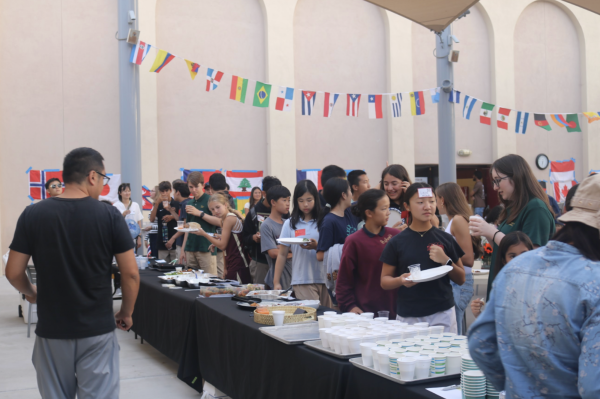Bachata!
Bishops celebrates Latinx Heritage Month
Students were able to receive many aspects of Latin culture at the event, including some of the table decorations.
If you were to be on the Lunch Terrace on September 16, the only Salsa you would find would be on the dance floor.
Last Friday the Latinx American Student Organization (LASO) had its 5th annual celebration of Mexico’s independence day, El Grito de Independencia, where the organization provided food, music, and dance lessons for the attendees.
Before the dance floor was packed, LASO packed the stomachs of the attendees with scrumptious traditional South American food. The main dish LASO served was empanadas, a traditional Argentinian dish. Sofia Holman, a junior in LASO, described empanadas as “meat wrapped in bread.” She continued, “sometimes they are baked, sometimes they are fried. The ones today we have here are baked, and they are really good.”
After eating, the participants transitioned from the dining tables to the dance floor to begin learning Bachata dancing. The instructor hired, Carlos, organized the dancers in rows, teaching them the steps. Bachata, meaning “party” or “celebration”, is a style of music and dance originating from the Dominican Republic that is now widespread in Latin American culture. After learning the Bachata, the group was then taught the more fast paced and largely popular Salsa dance.
The 40 or so student dancers gathered a crowd of onlookers, some arriving late to the event from sports practices. Lanie Beamer (‘25) found it “fun watching the people getting really into the dancing.” Her description of the participants’ enthusiasm was more than apt.
The impressive dancing was all orchestrated by Carlos who has been dancing for 17 years and teaching Salsa and Bachata for 10. The Dancing aficionado commended the willingness of the participants to learn about a new culture; “they are pretty enthusiastic which is not always what I get when I’m teaching teenagers.” He went on to explain, “There is often more skepticism which is understandable but here people seem pretty excited and there are some people here with innate rhythm which is pretty impressive.”
For the Latinx participants, the event served as a welcomed opportunity to experience an aspect of their culture that is often overlooked in America. The instructor explained that “it feels awesome that they are celebrating it here because in the U.S. you usually see only Cinco De Mayo celebrations.”
For Jazzy Rodriguez (‘23) the event served as an opportunity for her to “be able to dance and learn about her culture deeper than what I have been able to previously because I haven’t been able to take advantage of Salsa or Bachata classes previously.”
Jazzy went on to explain that the event marks a return of LASO, which she described as having grown stagnant as a result of the covid-19 pandemic. She said, “it’s really nice to just enjoy my culture again.” She explained that the event to her meant being “able to share these events with the school, people who aren’t even aware of LASO and what it means to be or have the identity of being latinx.”
For those outside the Latinx community the event served as an insight into a culture they usually don’t get to experience. For Rithvik Raguram (‘24) the event was “a really fun experience.” Another junior, Nathan Xiong, ecstatically remarked, “I learned how to do the 1,2,3!”
Señora Torres, the organizer of the event, explained the origin of the tradition of Bachata and Salsa dancing here at Bishop’s. “The actual dance part of it came, I don’t know, five years ago maybe? At the time, Ms Codd was working here. She and I went to a dance lesson and I said to her , ‘You know I think the kids at Bishop’s would really dig having someone be the instructor’ ”
Smiling, Sra. continued, “the first year we had just a small group of students and then the word got out and then the second time we did it there were more people and this is the most we’ve had.”
To Sra. Torres, the holiday “highlights the contributions of Latinx folks to American culture while honoring their own.” She believes that “It’s something we should do for all cultures all the time.”
She commended the United States and their designation of the month of September for latinx heritage.“It gives us a chance to reflect on what we’ve brought to the table as Latinx Americans.” She explained that celebrations of cultural holidays like this help people with multicultural heritage. “It’s neat to have a foot in each culture and it enriches people’s lives.”

Dane Jorgensen is a junior at The Bishop’s School, a member of the Varsity Lacrosse and football team, and was once a sponsored Dungeons and Dragons...



![(from left to right) Nathaniel Hendrickson (‘31), Benjamin Hill (‘31), and Cameron Sibley (‘31) are all smiles as they pet Brady, Ben’s spotted dog, who was blessed. “[Brady] was very excited and happy to be there,” he said.](https://thebishopstower.com/wp-content/uploads/2025/10/Screenshot-2025-10-13-at-8.45.50-AM-600x449.png)


![Leia (‘30) and Sara Park (‘32) ended their combative performance with a yell known as a kiyap. Leia explained with a proud smile, “I realized this when I was little, but not many people see taekwondo every day. For me, it’s a daily occurrence, so it feels very normal…when I do [a performance] in public, everyone’s like ‘Wow, that’s really cool’. So it always reminds me how this isn’t a normal thing in other people’s lives and I think it’s really cool that I can share that.”](https://thebishopstower.com/wp-content/uploads/2025/10/Screenshot-2025-10-02-at-2.07.47-PM-600x583.png)